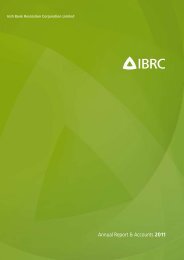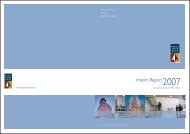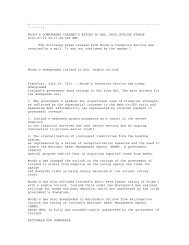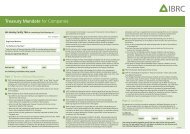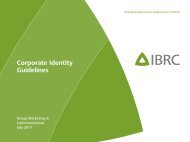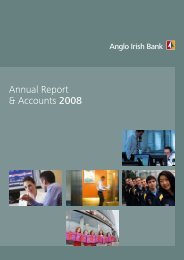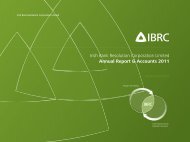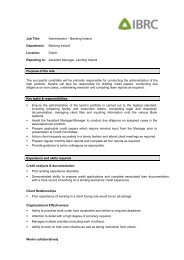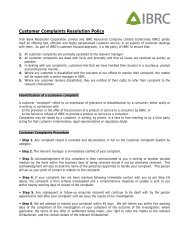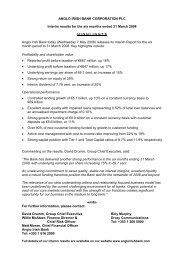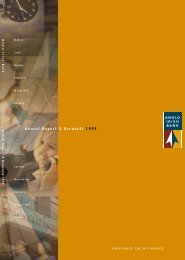Annual Report & Accounts 2009 - Anglo Irish Bank
Annual Report & Accounts 2009 - Anglo Irish Bank
Annual Report & Accounts 2009 - Anglo Irish Bank
You also want an ePaper? Increase the reach of your titles
YUMPU automatically turns print PDFs into web optimized ePapers that Google loves.
Netting arrangements<br />
The Group has entered into master netting agreements with counterparties with which it undertakes a significant amount of<br />
transactions, primarily in the interbank markets for derivative instruments and repurchase transactions. As these transactions<br />
usually settle on a gross basis, the ability to settle on a net basis in the event of a default substantially reduces the overall credit<br />
risk.<br />
Parent <strong>Bank</strong> credit risk<br />
Additional information on the parent <strong>Bank</strong>'s credit risk is contained in note 56.<br />
Market risk<br />
Market risk is the risk of a potential adverse change in the Group’s income or financial position arising from movements in<br />
interest rates, exchange rates or other market prices. Market risk arises from the structure of the statement of financial<br />
position, the execution of customer and interbank business and from trading activities. The Group recognises that the effective<br />
management of market risk is essential.<br />
The Group's exposure to market risk is governed by policies prepared by Group Risk Management in consultation with Group<br />
Treasury and approved by ALCO and the Risk and Compliance Committee. All risk limits are approved by ALCO and the Risk<br />
and Compliance Committee.<br />
Exposure to market risk is permitted only in specifically designated business units and is centrally managed by Group Treasury.<br />
In other units, market risk is eliminated by way of appropriate hedging arrangements with Group Treasury. Market risk<br />
throughout the Group is measured and monitored by Group Risk Management, operating independently of the business units.<br />
The table below summarises the VaR levels of the Group’s trading book for the period using a 99% confidence level.<br />
1 Day Time<br />
Horizon<br />
<strong>Anglo</strong> <strong>Irish</strong> <strong>Bank</strong><br />
<strong>Annual</strong> <strong>Report</strong> & <strong>Accounts</strong> <strong>2009</strong><br />
Trading book risk<br />
The trading book consists of positions arising primarily from client transactions in a range of financial instruments. The interest<br />
rate trading book includes interest rate swaps, currency swaps, interest rate futures, forward rate agreements and options.<br />
Traded foreign exchange risk arises from the Group’s lending and funding activities as well as from its corporate and interbank<br />
foreign exchange business. All trading book risks are managed centrally by Group Treasury.<br />
The primary trading book market risk measure is a Value at Risk ('VaR') model that is based on a historical simulation<br />
methodology. It is implemented using a 99% confidence level and two years of historic data. The methodology takes into<br />
account inter-relationships between different market variables, for instance between interest rates and foreign exchange rates,<br />
and captures the risks associated with option positions in interest rate and foreign exchange instruments.<br />
Although an important and industry standard measure of risk, VaR has its limitations as a result of its use of historical data,<br />
frequency of calculation and holding periods. Additionally, the use of confidence intervals does not give any information about<br />
potential losses when the confidence level is exceeded. For these reasons, the Group also uses a variety of other methodologies<br />
in measuring market risk. These include, but are not limited to, stress testing and sensitivity analysis.<br />
10 Day Time<br />
Horizon<br />
31 December 30 September 31 December 30 September<br />
<strong>2009</strong> 2008 <strong>2009</strong> 2008<br />
€m €m €m €m<br />
At end of period 0.3 0.4 0.9 1.3<br />
Average 0.5 0.2 1.6 0.6<br />
Minimum 0.3 0.1 0.9 0.3<br />
Maximum 0.8 0.7 2.5 2.2<br />
The average VaR for the period ended 31 December <strong>2009</strong> was higher than for the previous year. Risk positioning continued to<br />
be low in <strong>2009</strong> in terms of interest rate and foreign exchange risk sensitivities, reflecting a cautious stance in the face of<br />
uncertainty in global financial markets. The higher average VaR for the period resulted from the significantly higher volatility in<br />
certain key market data for the 15 months to 31 December <strong>2009</strong>.<br />
Group Risk Management provides daily reporting of trading book risk positions against all approved VaR, Present Value of a<br />
Basis Point ('PVBP'), option sensitivity and stop-loss limits. It provides monthly reporting to ALCO on trading book activity with<br />
analysis of all significant risk positions, including stress testing of positions against a range of extreme market scenarios. There<br />
is also monthly reporting to the Risk and Compliance Committee on compliance with trading limits.<br />
123



